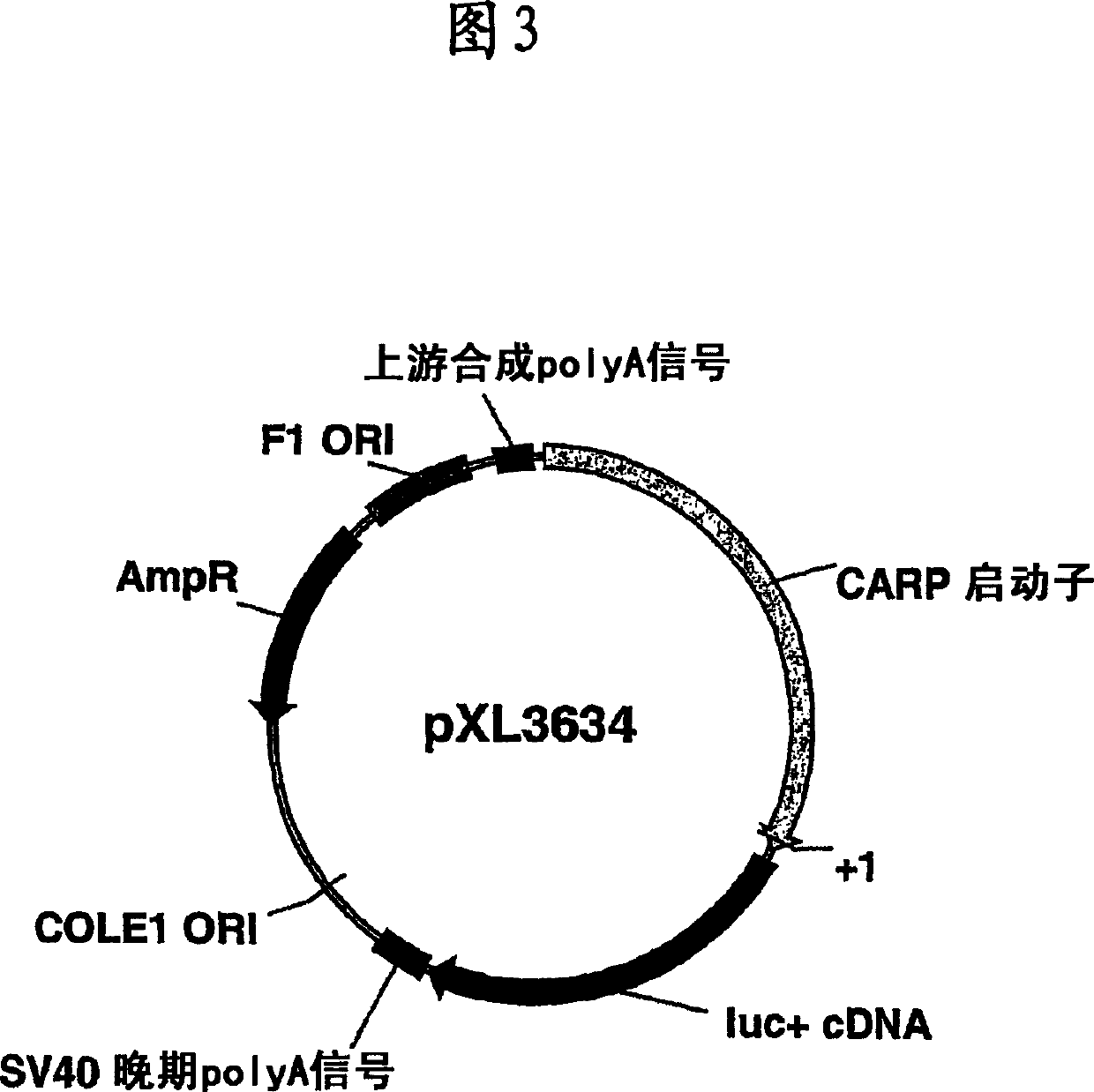Heart ankyrin repeat protein gene upstream sequence, carrier containing the same sequence and usage thereof
A technology of sequences and vectors, applied in the field of design and development of new systems, which can solve problems such as low activity levels
- Summary
- Abstract
- Description
- Claims
- Application Information
AI Technical Summary
Problems solved by technology
Method used
Image
Examples
Embodiment 1
[0086] Example 1: Characterization of upstream polynucleotides of CARP gene
[0087] The 2.3Kb BamHI-XhoI fragment of the 5' sequence of the mouse gene encoding the CARP protein was cloned by the chain termination method (Sanger et al., 1977, PNAS, 74, 5463) using the Sequenase Kit (United States Biochemical, Cleveland, Ohio) Both strands are sequenced. The sequence is shown in Figure 1 and thus contains between nucleotides -2266 and +92 (relative to the transcription site +1) a part upstream of the gene encoding the mouse CARP protein (SEQ ID NO: 1).
Embodiment 2
[0088] Embodiment 2: Construction of CARP plasmid vector
[0089] 2.1 Plasmid pXL3634
[0090] The 2.3 Kb BamHI-XhoI fragment characterized in Example 1 was cloned into plasmid pGL3-Basic (Promega) previously digested with XhoI and SmaI after filling in the BamHI site to obtain plasmid pXL3634. Figure 3 shows a schematic representation of the plasmid.
[0091] 2.2 Plasmid pXL3728
[0092] Plasmid pXL3728 was obtained from plasmid pXL3179, a vector derived from plasmid pXL2774 (WO 97 / 10343), into which a fusion of cDNA encoding human fibroblast interferon signal peptide and FGF1 (fibroblast growth factor 1) was introduced The gene (sp-FGF1, Jouanneau et al., PNAS 88 (1991), 2893-2897), placed in the promoter obtained from the human giant cell early region (hCMV IE) and the polyadenylation of the SV40 virus late region (GenBankSV4CG) under the control of acidification signaling.
[0093] The 2.3 Kb BamHI-XhoI fragment characterized in Example 1 was cloned into the plasmid pX...
Embodiment 3
[0096] Example 3: Comparison of plasmids
[0097] 3.1 Plasmids pXL3130 and pXL3153
[0098] Plasmids pXL3130 and pXL3153 contain human smooth muscle α-actin promoter (-680, +30) and mouse SM22 promoter (-436, +43) coupled to CMV enhancer (-522, -63), respectively, As described in application WO 00 / 18908.
[0099] 3.2 Plasmid pXL3635
[0100]RSV-229 was cloned by PCR from a construct containing a longer form of the RSV promoter (contained in Ad1.0RSVLAcZ, Stratford-Perricaudet et al., J Clin Invest 90 (1992) 626-30), the +34 promoter, The primers 5'-GGC GAT TTAAAT AAT GTA GTC TTA TGC AAT-3' and 5'-GGG GTC TAG AAGGTG CAC ACC AAT GTG GTG A-3' were used in the PCR to introduce a SwaI and XbaI sites. The promoter fragment was then introduced into pGL3-basic using these two restriction sites to generate pXL3635.
[0101] 3.2 Plasmid pXL3031
[0102] Plasmid pXL3031 was described by Soubrier et al., Gene Ther. 6 (1999), 1482-8. It is a vector derived from the plasmid pXL2774 (...
PUM
 Login to View More
Login to View More Abstract
Description
Claims
Application Information
 Login to View More
Login to View More - R&D
- Intellectual Property
- Life Sciences
- Materials
- Tech Scout
- Unparalleled Data Quality
- Higher Quality Content
- 60% Fewer Hallucinations
Browse by: Latest US Patents, China's latest patents, Technical Efficacy Thesaurus, Application Domain, Technology Topic, Popular Technical Reports.
© 2025 PatSnap. All rights reserved.Legal|Privacy policy|Modern Slavery Act Transparency Statement|Sitemap|About US| Contact US: help@patsnap.com



